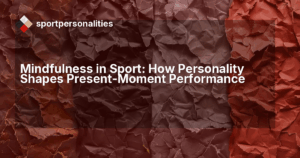Meditation for Athletes: How Personality Shapes Effective Mental Training
The basketball player sits cross-legged in the corner of the gym, trying to clear her mind like the meditation app instructed. Five minutes in, she's fidgeting. Ten minutes in, she's mentally reviewing tomorrow's game plan. Fifteen minutes later, she gives up entirely, convinced meditation just isn't for her.
Here's what nobody told her: meditation for athletes isn't one-size-fits-all. The same athlete who struggles with traditional meditation might thrive with an entirely different approach, one that actually matches how his brain naturally works during competition.
Athletes process mental training as differently as they approach competition itself. The techniques that help one athlete find focus might bore another to tears or ramp up a third's anxiety.
Most meditation programs for athletes treat everyone identically. Sit still. Focus on breath. Clear your mind. But research in sport psychology reveals something crucial: athletes process mental training as differently as they approach competition itself. The techniques that help one athlete find focus might bore another to tears or ramp up a third's anxiety.
The Problem with Standard Meditation Programs
Walk into any sports psychologist's office and you'll likely encounter similar meditation recommendations. Mindfulness breathing. Body scans. Visualization exercises. These aren't bad techniques, they're just incomplete.
Traditional meditation programs ignore a fundamental reality: your cognitive wiring during competition directly shapes which mental training methods actually work for you. An athlete who relies on split-second instincts needs different meditation tools than one who does well by planning ahead. An athlete motivated by personal records approaches meditation differently than one fueled by defeating rivals.
According to the SportPersonalities Four Pillars framework, four distinct psychological dimensions determine how athletes experience competition, and by extension, which meditation approaches will actually stick. These dimensions include how you process information during performance (tactical planning versus reactive instinct), what drives your competitive fire (internal satisfaction versus external validation), where you direct competitive energy (self-improvement versus opponent defeat), and whether you thrive in collaborative or autonomous environments.
These aren't trivial personality quirks. They're hardwired patterns that show up consistently under pressure. And they completely transform which meditation techniques enhance performance versus which ones just waste time.
When Traditional Meditation Backfires
Consider the athlete with a reactive cognitive style, someone like  The Maverick (IORA) or
The Maverick (IORA) or  The Sparkplug (ESRC). These athletes make their best competitive decisions through instinct, processing multiple information streams simultaneously without conscious deliberation. Their genius lies in spontaneity.
The Sparkplug (ESRC). These athletes make their best competitive decisions through instinct, processing multiple information streams simultaneously without conscious deliberation. Their genius lies in spontaneity.
Now imagine asking them to sit motionless for twenty minutes, systematically scanning body parts while attempting to suppress every thought. It's cognitive torture. Their strength is responsive awareness, not forced stillness. Traditional meditation doesn't calm their minds, it creates internal conflict between their natural processing style and an incompatible technique.
Reactive athletes aren't failing at meditation. The meditation approach is failing them when it forces stillness instead of working with their natural responsive awareness.
They're not failing at meditation. The meditation approach is failing them.
The same mismatch happens in reverse.  The Duelist (IOTA) or
The Duelist (IOTA) or  The Captain (EOTC), athletes who excel through strategic analysis and tactical preparation, often struggle with purely reactive meditation approaches. Telling them to "just be present" without structure feels aimless. Their minds naturally organize, categorize, and strategize. Effective meditation for them works with this tendency, not against it.
The Captain (EOTC), athletes who excel through strategic analysis and tactical preparation, often struggle with purely reactive meditation approaches. Telling them to "just be present" without structure feels aimless. Their minds naturally organize, categorize, and strategize. Effective meditation for them works with this tendency, not against it.
Matching Meditation to Your Competitive Wiring
So what does personality-matched meditation actually look like? It starts with understanding your own cognitive and motivational patterns.
For the Strategic Thinkers (Tactical Athletes)
Athletes with tactical cognitive styles process competition through systematic analysis. Their meditation practice should leverage this strength. Structured visualization works beautifully here, mentally rehearsing specific competition scenarios, analyzing decision trees, and imagining tactical adjustments to different situations.
These athletes benefit from meditation approaches that feel purposeful. A twenty-minute visualization session where they mentally prepare for tournament conditions isn't just meditation, it's strategic preparation that happens to build focus and emotional regulation. Body scan meditations work better when framed as tactical awareness training, systematically cataloging physical sensations to recognize fatigue or tension patterns before they impact performance.
The key: give the analytical mind something productive to analyze.
For the Instinctive Performers (Reactive Athletes)
Reactive athletes need meditation that honors their strength in spontaneous awareness. Static, structured sessions feel constraining. Instead, they thrive with dynamic meditation approaches.
Movement meditation transforms mental training into something natural. A basketball player shooting free throws while maintaining present-moment awareness. A runner focusing on breath rhythm and foot strike during an easy recovery jog. A martial artist practicing forms while attending to subtle body mechanics. This isn't a distraction from meditation, it's meditation that works with reactive processing instead of fighting it.
These athletes also excel with brief, frequent meditation moments rather than extended sessions. Thirty seconds of focused breathing before each training set. A quick body check between competition attempts. Multiple short mental resets scattered throughout the day rather than one long formal practice.
For the Other-Referenced Competitors
Athletes who define success through defeating opponents, sport profiles like  The Gladiator (EORA) or
The Gladiator (EORA) or  The Rival (EOTA), often resist meditation because it feels disconnected from competitive dominance. Why sit breathing when you could be training harder than your competitors?
The Rival (EOTA), often resist meditation because it feels disconnected from competitive dominance. Why sit breathing when you could be training harder than your competitors?
The solution: reframe meditation as competitive intelligence. These athletes respond to meditation practices explicitly designed for competitive advantage. Visualization focused on opponent tendencies and counter-strategies. Mental rehearsal of high-pressure scenarios where rivals typically crack. Meditation sessions specifically calibrated to build the focus required during head-to-head battles.
When meditation becomes a tool for outsmarting and outperforming opponents rather than generic stress reduction, suddenly it fits these athletes' motivational structure.
For the Self-Referenced Improvers
Athletes measuring success against their own standards and personal evolution, like  The Purist (ISTA) or
The Purist (ISTA) or  The Flow-Seeker (ISRA), often naturally gravitate toward meditation. The introspective, self-focused nature aligns with their competitive orientation.
The Flow-Seeker (ISRA), often naturally gravitate toward meditation. The introspective, self-focused nature aligns with their competitive orientation.
These athletes benefit most from meditation emphasizing technical awareness and skill refinement. Mindfulness practices that build proprioceptive precision. Body-based meditation that enhances movement quality awareness. Contemplative sessions exploring the relationship between mental state and performance execution.
They're less interested in meditation for stress management and more drawn to practices that deepen the athlete-sport connection. Meditation becomes exploration of their own potential rather than a performance-optimization hack.
Building a Practice That Actually Sticks
Understanding your meditation style matters little without consistent implementation. Here's where personality awareness becomes practically useful.
Athletes with autonomous social styles, those who thrive on self-direction like  The Daredevil (ESRA) or
The Daredevil (ESRA) or  The Record-Breaker (ESTA), build meditation practices most effectively through self-guided exploration. Give them frameworks and principles, then let them experiment. They'll discover what works through trial and refinement, developing personalized approaches that feel authentic rather than prescribed.
The Record-Breaker (ESTA), build meditation practices most effectively through self-guided exploration. Give them frameworks and principles, then let them experiment. They'll discover what works through trial and refinement, developing personalized approaches that feel authentic rather than prescribed.
Collaborative athletes, those who draw energy from group settings like  The Harmonizer (ISRC) or
The Harmonizer (ISRC) or  The Motivator (ESTC), benefit enormously from team meditation practices. Group sessions before training. Shared meditation apps with teammate accountability. Partner visualization exercises. The social element isn't a distraction from meditation, it's the ingredient that makes practice sustainable.
The Motivator (ESTC), benefit enormously from team meditation practices. Group sessions before training. Shared meditation apps with teammate accountability. Partner visualization exercises. The social element isn't a distraction from meditation, it's the ingredient that makes practice sustainable.
Athletes motivated by external validation need meditation structures with visible progress markers, while intrinsically motivated athletes need approaches emphasizing inherent satisfaction like immediate calm and enhanced body awareness.
Athletes motivated primarily by external validation need meditation structures with visible progress markers. Apps that track streaks. Coaches who check in about practice consistency. Integration with performance metrics showing how meditation correlates with competition results. These aren't shallow motivational tricks, they're alignments between meditation program design and authentic motivational architecture.
Intrinsically motivated athletes, conversely, often resist gamified meditation systems that feel artificial. They need meditation approaches emphasizing inherent satisfaction, the immediate calm after breathing exercises, the enhanced body awareness during movement meditation, and the mental clarity following visualization practice. The practice itself provides sufficient reward without external metrics.
Find Your Sport Personality Type
Meditation is a great tool but it doesn't work the same for everyone. Knowing your personality type is the first step!
Start the Free AssessmentThe Meditation Mistakes Your Personality Makes You Vulnerable To
Understanding your meditation strengths also reveals your likely pitfalls.
Tactical thinkers easily fall into over-complicating meditation. They research seventeen different techniques, analyze which neuroscience studies show the strongest effects, and create elaborate tracking systems, then never actually sit down and practice. Their strategic strength becomes analysis paralysis. The fix: pick one approach, commit to two weeks of daily practice before evaluating, then adjust based on actual experience rather than theoretical optimization.
Reactive performers often mistake meditation's initial discomfort for incompatibility. Because their natural state is responsive motion, any practice requiring extended stillness feels wrong at first. They abandon techniques before adaptation occurs. The solution: shorter initial sessions (even five minutes), immediate post-meditation activity to avoid feeling trapped, and explicit acknowledgment that discomfort doesn't mean failure.
Other-referenced athletes tend to skip meditation entirely when competitive pressure drops, off-seasons, post-victory periods, and times when no rivals threaten their position. This creates exactly the wrong pattern, building mental skills only when pressure is highest rather than establishing resilience beforehand. Better approach: reframe meditation as competitive preparation for future battles, maintaining practice even when immediate threats aren't visible.
Self-referenced athletes sometimes become so focused on meditation technique perfection that they miss the actual point, developing practical focus skills for competition. They'll obsess over whether their breathing pattern is optimal while neglecting to notice whether meditation actually helps them compete better. The correction: regularly connect meditation practice back to performance outcomes, treating technique as a means rather than an end.
What Elite Athletes Actually Do Differently
The most successful athlete meditation practices rarely look like the stereotypical monk sitting in lotus position. They're integrated into existing routines, adapted to individual psychology, and pragmatically focused on competitive outcomes.
A tactical athlete might spend ten minutes before sleep mentally walking through tomorrow's competition venue, visualizing successful execution of planned strategies while incorporating breath awareness to manage pre-competition anxiety. That's meditation, even if it doesn't involve candles and cushions.
A reactive athlete might practice present-moment awareness during warm-up routines, using familiar movement patterns as meditation anchors. Thirty seconds of focused attention on muscle activation during each stretch becomes cumulative mental training without formal sitting practice.
A collaborative athlete might establish a team tradition of brief guided meditation before practice, building both individual focus skills and group cohesion simultaneously. Five minutes of shared breathing exercises becomes sustainable because the social element maintains consistency.
An autonomous athlete might develop a personal pre-performance ritual incorporating visualization and body scanning, practiced in solitude as sacred preparation time. The independence of the practice makes it feel authentic rather than imposed.
Your Next Step: Design a Meditation Practice Around Your Personality
Meditation for athletes works when it matches your psychological wiring, your cognitive approach, motivational structure, competitive focus, and social preferences. The SportPersonalities framework reveals these patterns, transforming meditation from generic stress reduction into personalized mental training.
Start by identifying your own cognitive and motivational patterns. Are you reactive or tactical during competition? Do you focus on defeating opponents or surpassing personal standards? Are you energized by external recognition or internal satisfaction? Do you prefer autonomous training or collaborative environments?
Then experiment with meditation approaches aligned to those patterns. Tactical athletes should try structured visualization and strategic mental rehearsal. Reactive athletes should explore movement meditation and brief awareness practices. Opponent-focused athletes should frame meditation as competitive preparation. Self-referenced athletes should emphasize technique refinement and flow state exploration.
The goal isn't becoming a meditation master. It's developing sustainable mental training that actually enhances your competitive performance. When meditation matches your personality, consistency becomes natural. When it fights your wiring, even the strongest discipline eventually breaks down.
Your mental training should look different than your teammate's. That's not a problem to solve but a competitive intelligence to exploit.
Find Your Sport Personality Type
Meditation is a great tool but it doesn't work the same for everyone. Knowing your personality type is the first step!
Start the Free AssessmentReferences
- The relationship between mindfulness and athletes’ mental skills may be explained by emotion regulation and self-regulation (Pmc.ncbi.nlm.nih.gov)
- Mindfulness Training Enhances Endurance Performance and Executive Functions in Athletes: An Event-Related Potential Study (Pmc.ncbi.nlm.nih.gov)
- Sports psychology: Mental preparation for competition (Stcharleshealthcare.org)
- Effect of mindfulness-based intervention on endurance performance under pressure and performance-relevant mental attributes, an interdisciplinary perspective (Sciencedirect.com)
- A meta-analysis of the intervention effect of mindfulness training on athletes’ performance (Frontiersin.org)
This content is for educational purposes, drawing on sport psychology research and professional experience. I hold an M.A. in Social Psychology, an ISSA Elite Trainer and Nutrition certification, and completed professional training in Sport Psychology for Athlete Development through the Barcelona Innovation Hub. I am not a licensed clinical psychologist or medical doctor. Individual results may vary. For clinical or medical concerns, please consult a licensed healthcare professional.







